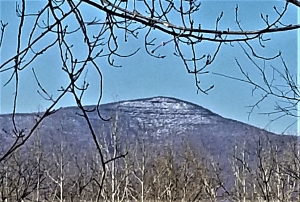Windham High Peak’s peak
The Catskill Geologists; Apr. 5, 2019
Robert and Johanna Titus
It won’t be long before the leaves are out, and it will be summer again. That will be just fine with us; it will let us out to go see all sorts of geology – sort of. In a way we wish we could make one big modification with winter. We wish we could make it a lot warmer. You see, for geologists, there are real advantages to having a season when there are no leaves. They typically get in the way of seeing the rocks. But it is so cold. So, if we had our way, it would be warm all year round, but there would still be pretty fall foliage and a “winter” without leaves. We would get out and do a lot of geology during that kind of winter. Oh well, we just have to deal with the seasons as they are.

Take a good look at our photo. It shows the summit of Windham High Peak as we see it right now in late February. Notice that you can really see the rocks up there. Look carefully. Those rocks are stratified; they are layered. They represent successive chapters in the geological history of the Catskills. These rocks are old, they date back about 385 million years, to what’s called the Devonian time period. Each horizon is petrified sediment. These layers were once sand, silt and clay, deposited on top of the Devonian Catskill Delta. It was big, even larger than today’s Mississippi Delta.
Exactly what kinds of rocks are they? You might think that they are too far away to tell, but that is not the case. The light-colored horizons were covered with snow when we took the photo. The dark strata somehow escaped the snow. That tells us a lot. Those dark horizons are cliffs; they are vertical, so no snow accumulated on them. The light-colored strata are not cliffs; they have relatively gentle slopes and did indeed pile up snow. So, the cliffs are dark, and the gentle slopes are snowy white. That’s nice but just what, exactly, does that tell us about rock type? A lot — it turns out.
The cliffs are composed of tough stuff, sandstone. Throughout the Catskills the thick sandstones are ancient river deposits; these were the sands that filled the river channels of the Devonian aged Catskill Delta. Gentle slopes are composed of softer rocks, these are mostly shales composed of silt and clay. Those are the old floodplain deposits. They are too soft to make cliffs; erosion always sculpts them into gently inclined slopes.
Please remember all this, next summer, when you are out climbing trails up the slopes of our mountains. You will commonly find yourself ascending relatively gentle slopes and then you will come across the trail blocked by a steep sandstone ledge. Suddenly you will have a little climbing to do. But, above that, you will find another gentle slope which will bring you to another sandstone. And so on, until you get to the very top of the trail — and of the mountain. You will have been climbing across Devonian stream channels, one after another. You will have been hiking across one Devonian floodplain after another. But, of greatest importance, you will be hiking with just a little more awareness of your surroundings; a little more real understanding of them. You, also, will have just a little bit more true comprehension of our mountains. And that is what this column is all about.
Contact the authors at randjtitus@prodigy.net. Join their facebook page “The Catskill Geologist.





